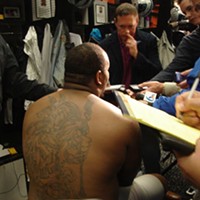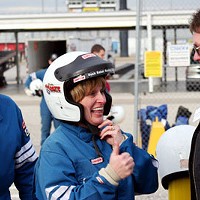The Iceman Cometh
A 9-miles-per-hour thrill ride atop the Checkers' nonstop Zamboni
By Jared NeumarkThere's only one cool way to see the new arena, and if you aren't special -- say, a wealthy business tycoon or the inventor of dryer sheets -- your chances of getting the royal tour aren't very good. I'm neither a tycoon nor an inventor, but publicity is a powerful bargaining chip, so the good people who run the Checkers agreed to let me ride the Zamboni during the first intermission in a contest against the Pensacola Ice Pilots.
The Zamboni is a boxy machine designed specifically for leveling the uneven craters that ice skates create. It sprays the 23-degree ice with 130-degree water while a blade on the bottom scrapes up the existing top layer. Then, like a wood chipper, an auger shoots ice slush into a tank that makes up the $80,000 machine's bulky body. At nearly its maximum speed of nine miles per hour, the Zamboni makes loops around the ring until the whole floor looks like a laminated sheet of paper.
Here's the catch: The Zamboni can't stop. No matter what. It has brakes, but if driver Scott Honeycutt uses them on the ice, it's game over. In a matter of seconds the heated water will burn all the way through the inch-and-a-half sheet of ice (50 to 100 layers), down to the wooden boards that lie beneath it.
"So, it's like the movie Speed?" I ask.
"Yes," Scott says, and chuckles. "Exactly."
"Sweet!"
But it's not sweet for people who get in the Zamboni's way. There's no horn, and oftentimes (especially at minor-league games) people go on the ice to promote various causes. The Zamboni isn't a gentleman -- it hits women and children just the same. "It takes but one time before people learn to get out of the way," says Scott.
Once, on a seemingly routine intermission ride, a kid aboard the Zamboni turned out to be a screamer when the machine hit the ice. He began to have a fit and looked like he might jump off. Scott had to make a decision. He could take his chances and continue riding with the kid. Maybe the crying would be the extent of his freakout. But what if the kid jumped? It would make front-page headlines. Or, Scott could stop, ruin the floor and the game would end prematurely. (Option three: he could shoot the hostage.)
Scott had another plan. He signaled for the other groundskeepers to open the gate, and he drove the machine off the ice.
On the ice, Scott has to manage three wheels: One adjusts the water, one maneuvers the blade and one steers. At the same time, he has to be personable with his typically loquacious guest while being on the constant lookout for a nut or bolt. Recently, after Disney On Ice, he let a minuscule nut get past him. It jammed the auger, stopped the machine and caused the ice to melt. The Checkers had to cancel the next game.
If you're worried about the Zamboni breaking down, don't. The city has supplied the arena with a back-up machine in case anything happens to Zamboni No. 1. (No, that $80,000 couldn't have been spent better.)
Scott has been driving a Zamboni for 11 years. He even had a stint in the pros with the Carolina Hurricanes. As with the players, there's a talent gap between minor-league Zamboni drivers and the pros. In the minors, the drivers have 12 minutes, a virtual eternity, to smooth out the ice. The pros' Zambonis are twice as wide, which makes them much harder to steer and avoid objects. What's more, the drivers in the NHL only have four minutes to do the job.
Before Scott was a Zamboni driver, he worked in a pit crew for a racing team. Members of pit crews train like any other professional athletes. They run and lift weights to cut seconds off their tire-changing time. Like driving the Zamboni, working in a pit crew is a high-pressure job. If you bobble one tire, you can be fired.
Scott was ready for the pressure of the big leagues. He wasn't ready for one of the biggest mascot tragedies in the history of sports, though. Early in the Hurricanes' inaugural season, a guy in promotions wanted to introduce the mascot in a special way. He thought it would be a great idea for the Zamboni to give birth to Stormy (the Hurricanes mascot that looks like a cross between a bear, squirrel and cow). So they hid Stormy in the tank that holds the ice. To make the birth more mystical and spectacular, they also put dry ice in the compartment (a practice that will hopefully catch on with all births).
No one in promotions knew that when dry ice combines with water, the product is pure carbon dioxide. Stormy was breathing nothing but poison for four minutes. After Scott helped him out of the tank, Stormy had a seizure on center ice during a nationally televised game. The worst part is the fans thought the mascot was just acting goofy. Stormy recovered for the most part, but he still takes seizure medication.
Nothing that dramatic happened while I was riding the Zamboni. During the game, I learned the team isn't named after the popular board game. OK, maybe it should have been obvious the name refers to checking, the hockey act of slamming an opponent into the wall.
I got to talk to one of the players, Peter Worrell, a former New York Ranger who led the NHL in penalty minutes in 2004. During the last game he played a few days earlier, he was ejected for fighting. Worrell knocked the guy out cold. At 6 feet, 7 inches, and 275 pounds, Worrell is huge.
"Why are you so mean?" I asked.
"That was my role. Everyone's role is defined. Not everyone can be a goal scorer," he said. "I understood from early on, being in the NHL, my job was to be a fighter and that's what I did."
Latest in Urban Explorer
More by Jared Neumark
-
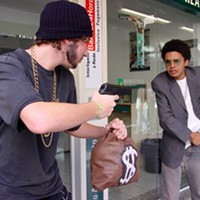
Best of The Blotter 2007
Nov 28, 2007 -
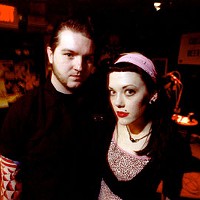
Preaching and drinking
Mar 7, 2007 -

Preaching and Drinking
Dec 27, 2006 - More »
Calendar
-

Wine & Paint @ Blackfinn Ameripub- Ballantyne
-
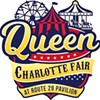
Queen Charlotte Fair @ Route 29 Pavilion
-
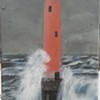
NEW WINDOW GALLERY-Pat Rhea-ACRYLIC PAINTINGS-April 05-30 2024 VALDESE, NC 28690 @ New Window Gallery/Play It Again Records
- Through April 30, 12 p.m.
-

TheDiscountCodes
-

Face to Face Foundation Gala @ The Revelry North End
-
Esports in Charlotte Takes Off: A Guide to Virtual Competitions and Betting
-
Homer's night on the town 41
If you drank a shot with the Knights mascot on Sept. 20, you were basically harboring a fugitive
-
Canuck in the Queen City 7
A Canadian transplant looks back at her first year as a Charlotte resident


